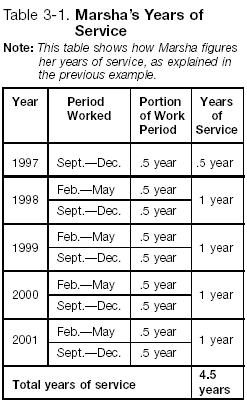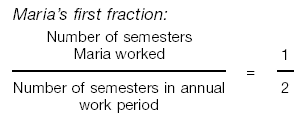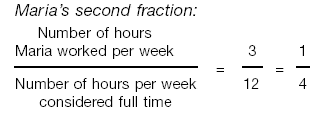Maximum Exclusion Allowance (MEA)
The maximum exclusion allowance (MEA) has been repealed for years beginning after 2001. When figuring your MAC for 2002 and later years, you will
not use MEA.
The maximum exclusion allowance (MEA) is the first component of MAC for 2001. Your MEA is the limit on the amount of contributions your employer
could make to your 403(b) account for 2001.
You need to figure your MEA separately for each employer who has established a 403(b) account for your benefit. When figuring your MEA, do not mix
the information of one employer with the information of another employer.
 More than one account, same employer. If during 2001, you have two or more 403(b) accounts maintained by the same employer, figure only
one MEA for all 403(b) accounts maintained by that employer because they are considered one account.
More than one account, same employer. If during 2001, you have two or more 403(b) accounts maintained by the same employer, figure only
one MEA for all 403(b) accounts maintained by that employer because they are considered one account.
More than one employer. If more than one employer contributed to a 403(b) account for you, you must figure a separate MEA for each
employer.
MEA formula.
To figure your MEA you will need to understand the following concepts.
- Years of service.
- Includible compensation for your most recent year of service.
- Amounts previously excludable.
Your MEA is 20% of your includible compensation for your most recent year of service multiplied by your years of service, and
then reduced by amounts previously excludable.
You can use Worksheet A, Maximum Exclusion Allowance (MEA), in chapter 13, to figure your MEA.
Church employees.
If you are a church employee, you may be able to use different rules when figuring your MEA. For more information, see chapter 7.
Years of Service
The first step in figuring your MEA is to determine your years of service. How you figure your years of service depends on whether you
were a full-time or a part-time employee, whether you worked for the full year or only part of the year, and whether you have worked for your employer
for an entire year.
You must figure years of service for each year during which you worked for the employer who is maintaining your 403(b) account.
If more than one employer maintains a 403(b) account for you in the same year, you must figure years of service separately for each employer.
Definition
Your years of service are the total number of years you have worked for the employer maintaining your 403(b) account as of the end of the year.
Figuring Your Years of Service
Take the following rules into account when figuring your years of service.
Status of employer.
Your years of service include only periods during which your employer was a qualified employer. Your plan administrator can tell you whether or not
your employer was qualified during all your periods of service.
Service with one employer.
Generally, you cannot count service for any employer other than the one who maintains your 403(b) account.
Church employee.
If you are a church employee, treat all of your years of service with related church organizations as years of service with the same employer. For
more information about church employees, see chapter 7 if you are figuring your MAC for 2001. If you are figuring your MAC for 2002, see chapter 9.
Self-employed ministers.
If you are a self-employed minister, your years of service include full and part years in which you have been treated as employed by a tax-exempt
organization that is a qualified employer.
Less than one year of total service.
Your years of service cannot be less than one year. If at the end of your tax year, you have less than one year of service (including service in
any previous years), figure your MEA as if you have one year.
Total years of service.
When figuring years of service, figure each year individually and then add the individual years of service to determine your total years of
service, ending with the year for which the MEA is being calculated. The total years of service will be used when figuring your MEA.
Example.
The annual work period for full-time teachers employed by ABC Public Schools is September through December and February through May. Marsha began
working with ABC schools in September 1997. She has always worked full time for each annual work period. At the end of 2001, Marsha had 4.5 years of
service with ABC Public Schools, as shown in Table 3-1.

Table 3-1. Marsha's Years of Service information
To figure your years of service, you must analyze each year individually and determine whether you worked full time for the full year or something
other than full time. When determining whether you worked full time or something other than full time, you use your employer's annual work period as
the standard.
Employer's annual work period.
Your employer's annual work period is the usual amount of time an individual working full time in a specific position is required to work.
Generally, this period of time is expressed in days, weeks, months, or semesters and can span two calendar years.
Example.
All full-time teachers at ABC Public Schools are required to work both the September through December semester and the February through May
semester. Therefore, the annual work period for full-time teachers employed by ABC Public Schools is September through December and February through
May. Teachers at ABC Public Schools who work both semesters in the same calendar year are considered working a full year of service in that calendar
year.
Full-Time Employee for the Full Year
Count each full year during which you were employed full time as one year of service. In determining whether you were employed full time, compare
the amount of work you were required to perform with the amount of work normally required of others who held the same position with the same employer
and who generally received most of their pay from the position.
How to compare.
You can use any method that reasonably and accurately reflects the amount of work required. For example, if you are a teacher, you can use the
number of hours of classroom instruction as a measure of the amount of work required.
In determining whether positions with the same employer are the same, consider all of the facts and circumstances concerning the positions,
including the work performed, the methods by which pay is determined, and the descriptions (or titles) of the positions.
Example.
An assistant professor employed in the English department of a university will be considered a full-time employee if the amount of work that he or
she is required to perform is the same as the amount of work normally required of assistant professors of English at that university who get most of
their pay from that position.
If no one else works for your employer in the same position, compare your work with the work normally required of others who held the same position
with similar employers or similar positions with your employer.
Full year of service.
A full year of service for a particular position means the usual annual work period of anyone employed full time in that general type of work at
that place of employment.
Example.
If a doctor works for a hospital 12 months of a year except for a one-month vacation, the doctor will be considered as employed for a full year if
the other doctors at that hospital also work 11 months of the year with a one-month vacation. Similarly, if the usual annual work period at a
university consists of the fall and spring semesters, an instructor at that university who teaches these semesters will be considered as working a
full year.
Other Than Full Time for the Full Year
If, during any year, you were employed full time for only part of your employer's annual work period, part time for the entire annual work period,
or part time for only part of the work period, your year of service for that year is a fraction of your employer's annual work period.
Full time for part of the year.
If, during a year, you were employed full time for only part of your employer's annual work period, figure the fraction for that year as follows.
- The numerator (top number) is the number of weeks, months, or semesters you were a full-time employee.
- The denominator (bottom number) is the number of weeks, months, or semesters considered the normal annual work period for the
position.
Example.
Jason was employed as a full-time instructor by a local college for the 4 months of the 2000 spring semester (February 2000 through May 2000). The
annual work period for the college is 8 months (February through May and July through October). Given these facts, Jason was employed full time for
part of the annual work period and provided ½ of a year of service. Jason's years of service computation for 2000 is as follows.

fraction 4/8
Part time for the full year.
If, during a year, you were employed part time for the employer's entire annual work period, you figure the fraction for that year as follows.
- The numerator (top number) is the number of hours or days you worked.
- The denominator (bottom number) is the number of hours or days required of someone holding the same position who works full
time.
Example.
Vance teaches one course at a local medical school. He teaches 3 hours per week for two semesters. Other faculty members at the same school teach 9
hours per week for two semesters. The annual work period of the medical school is two semesters. An instructor teaching 9 hours a week for two
semesters is considered a full-time employee. Given these facts, Vance has worked part time for a full annual work period. Vance has completed 1/ of a year of service, figured as shown below.

fraction 3/9
Part time for part of the year.
If, during any year, you were employed part time for only part of your employer's annual work period, you figure your fraction for that year by
multiplying two fractions.
Figure the first fraction as though you had worked full time for part of the annual work period. The fraction is as follows.
- The numerator (top number) is the number of weeks, months, or semesters you were a full-time employee.
- The denominator (bottom number) is the number of weeks, months, or semesters considered the normal annual work period for the
position.
Figure the second fraction as though you had worked part time for the entire annual work period. The fraction is as follows.
- The numerator (top number) is the number of hours or days you worked.
- The denominator (bottom number) is the number of hours or days required of someone holding the same position who works full
time.
Once you have figured these two fractions, multiply them together to determine the fraction representing your partial year of service for the year.
Example.
Maria, an attorney, teaches a course for one semester at a law school. She teaches 3 hours per week. The annual work period for teachers at the
school is two semesters. All full-time instructors at the school are required to teach 12 hours per week. Based on these facts, Maria is employed part
time for part of the annual work period. Her year of service for this year is determined by multiplying two fractions. Her computation is as follows.

fraction 1/2

fraction 3/12
Maria would multiply these fractions to obtain the fractional year of service:
Previous | First | Next
Publication Index | 2002 Tax Help Archives | Tax Help Archives | Home
